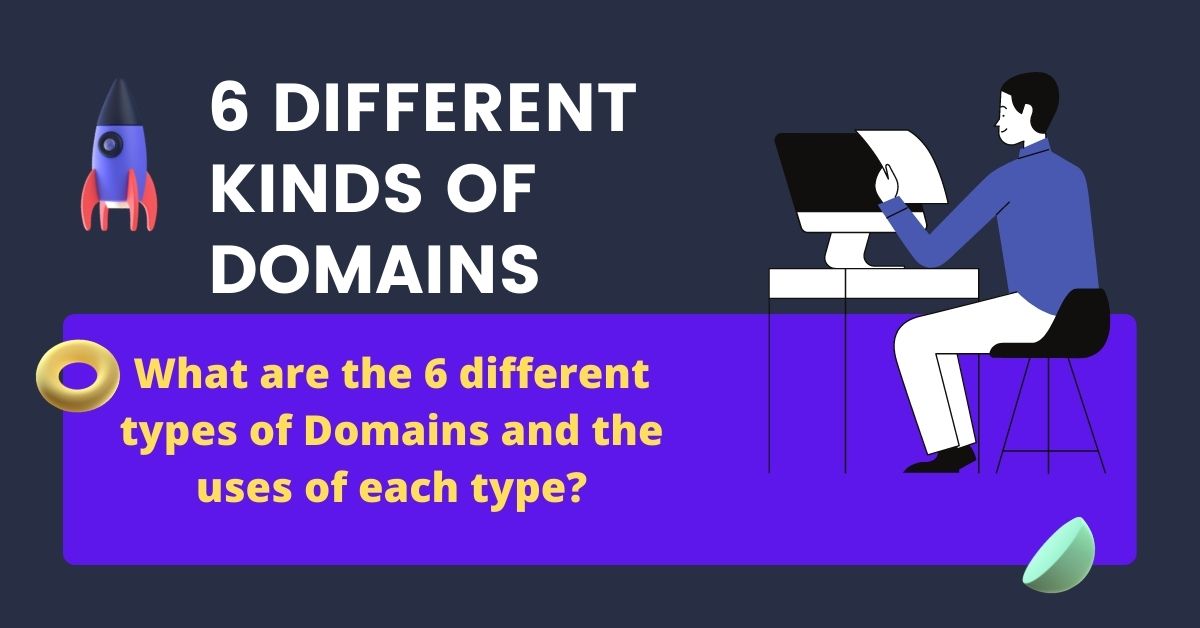6 Different Kinds of Domains. Not all domains function the same, therefore understanding the differences between the various types may be crucial when Creating a Website. For instance, while some domains have specific usage restrictions, others have unique meanings that should be considered.
However, there are ways to determine which domains are appropriate for your site and which ones should be avoided. After understanding the different components and varieties of domain names, one may choose one that will enhance both the user experience (UX) and the website’s reputation.
In this post, we’ll review different kinds of domains and how they work. After that, we’ll examine the various types of domain names and provide some advice on how to make the best choice. Come on, let’s get to work!
A Brief Overview of Domain Names
If you want to start your website, you must first understand what domain names are. A domain is the location of your website and what people will use to find you online. More specifically, the site’s domain is its core URL.
For instance, let’s have a look at ittrainingcoursesedelhi.in This is a straightforward URL for an Indian news website.

An Immediate Overview of How Domains Work
You can almost find anything you want online by just writing a URL or entering a search query into Google. This process typically feels quick, making it easy to forget what is happening behind the scenes.
Consider the domain name as an easy-to-remember phone number for the website to have a clearer picture of what happens when someone visits it. In some instances, businesses will display their phone numbers as letters to make them easier to remember, such as 1-800-CALL-NOW.
The fundamental rule for domains remains the same. Every website is stored on a server with an Internet Protocol (IP) address, such as 69.63.191.255. That is essentially the phone number for the website. The IP addresses, however, are difficult to remember because they are simply lists of numbers.
Therefore, instead of using these IP addresses, we use names that are simple to remember in their place. This works thanks to the Domain Name System (DNS), which we’ll see later.
Read Also: Top 10 Digital Marketing Challenges
What is the Domain Name System (DNS) and who runs it?
Similar to how phone numbers are organized, domain names are also arranged in a manner resembling a “book of address” This is the DNS (Domain Name System), a network of servers distributed throughout the world.
The DNS is what connects users to the websites they want to view. Use IP addresses as identifiers to locate the specific website to which you are attempting to gain access. The IP address is then converted into a format that we as humans can easily understand: the Domain Name.
Who is in charge of the DNS registries? The Internet Corporation for Assigned Names and Numbers (ICANN), a nonprofit organization, is responsible for that.
Knowing the Connection Between Domains and Web Hosting
In a few words, domains and web hosting are not the same. As we’ve seen, the domain marks the specific route to their website.
In contrast, Website Hosting is where their website resides. Your host provides the space and resources required for your website, storing them on specialized computers known as servers.
While it is possible to purchase a domain name separately from domain registrar websites, you can also obtain one through your web hosting provider. This could simplify your life a little because you’ll be able to manage your domain and hosting in the same location.
6 Different Kinds of Domains

After all, however, before registering for a domain, you must understand the various kinds of domains that are available to you. With that in mind, let’s have a look at the various terminology associated with the different kinds of domains.
1. Top-Level Domains (TLDs)
The first one among the kinds of domains is Top-Level Domains. Each website’s URL can be divided into various parts. The portion that follows immediately after a domain name’s primary name is known as a top-level domain (TLD), sometimes known as a domain extension (for instance, the .com)
However, in addition, to.com, there are other TLDs. You can choose from many options, such as.net, .blog, or.io (which was originally a country code but has since been adopted by the technological community).
You’re probably used to seeing TLDs like.com, .net, and a few other common ones. However, as Internet usage grows, so does the demand for exclusive domain names. Because of this, the ICANN started introducing new options to make it easier for people to find a domain name for their website that is not already taken.
2. Country Code Top-Level Domain (ccTLD)
There are actually many different types of TLDs, as we said earlier. For instance, the use of country-code top-level domains (ccTLDs) is restricted to certain countries.
Take Ireland as an example. Its ccTLD,.ie, is one of the safest to use. Other examples include the United Kingdom (.co. UK), Canada (.ca), India (.in), and even the United States (.us). All of these could be fantastic choices if the.com version of the domain name that the person had their heart set on has already been used.
However, keep in mind that this type of TLD may be somewhat restrictive if it pertains to an international audience. In reality, many businesses, like Amazon, use multiple TLDs for various regions.
3. Generic Top-Level Domain (gTLD)
One among the different kinds of Domains is Generic Top-Level Domains (gTLDs). You already know what they are even though you have never heard the term. These are the traditional domain extensions that we are all used to seeing, such as.com, .edu,.info, .org, and .net.
Since there weren’t as many TLD options available, these were initially contrasted with ccTLDs. However, we now have a new generation of TLDs to choose from (often called “new TLDs”).
Therefore, while choosing a domain, you’ll want to consider what would work best for your brand and your audience and choose something unique. After all, is said and done, you want people to remember your website so they can come back again and again.
4. Second-Level Domain (SLD)
We have now covered the TLD section of the domain name of a website. What’s going on with the rest of the URL, though? The second-level dominion arena is here (SLD).
Take a look back at our URL, for instance: Website: www.ittrainingcoursesedelhi.in The TLD is .in, as we have already seen. The SLD is what comes before it right away in this case, which is “ittrainingcoursesedelhi.”
The SLD is what people will associate with their website. It is crucial to take some time to think about your decision. It would be ideal to choose anything brand-related that would give visitors a sense of the focus and design of your website.
5. Third-Level Domain
We’ve now covered two of the three key components in any domain name. The last is appropriately known as the third-level dominion (not to be confused with the top-level domain).
As we’ve just mentioned, the TLD and SLD for www.ittrainingcoursedelhi.in are .in and ittrainingcoursedelhi, respectively. The third-level domain, sometimes known as the www portion, is what is left.
In either case, www. will be their third-level domain. However, for large corporations that require more web pages, that does not always work. As a result, it’s occasionally possible to see www1 or even www2 before SLD in a domain name.
6. Premium Domain
Sometimes when looking for a domain name, one discovers that the desired name is already taken. This indicates that it is a premium domain that belongs to someone else.
The good news is that you won’t necessarily have to give up that domain. In many cases, people purchase domain names but never use them. They might even be willing to sell a domain they are currently using if the price is right.
This is referred to as a domain resale or the private purchase of a domain owned by another individual. This generally means paying a little bit more for him than for a non-premium domain. However, in other instances, highly desirable domain names might cost hundreds or even thousands of dollars.
How to choose the best domain name for your website
One of the most significant decisions you will make as the owner of a website is choosing a domain name. After all, is said and done, whether you own a business or intend to expand your website, your domain name could have a significant impact on your reputation and visibility.
Therefore, it’s wise to have the following things in mind:
- At the least use appropriate keywords possible in your domain name. For instance, if an art business, you may want to include a keyword that’s specifically related to their business model. You can use Google Keyword Planner to aid in your research of keywords.
- It’s equally crucial to keep your domain name short and straightforward because it needs to be easy to remember. In general, it’s easier to remember one or two words than an entire sentence.
- Furthermore, it is crucial that whatever domain name you choose does not violate any commercial trademarks. Check to see whether there are any businesses or websites with names that are quite similar to yours, since this may help you ensure that your site has a secure beginning.
Conclusion:
Knowing the different kinds of domains is the first step in choosing the ideal one for your site. Fortunately, knowing a few basic terms and ideas can quickly put something in the right direction.
Content Source: Google.com
| Follow Us On Google News | Click Here |
| Facebook Page | Click Here |
| Telegram Channel | Click Here |
| Click Here | |
| Website | Click Here |
